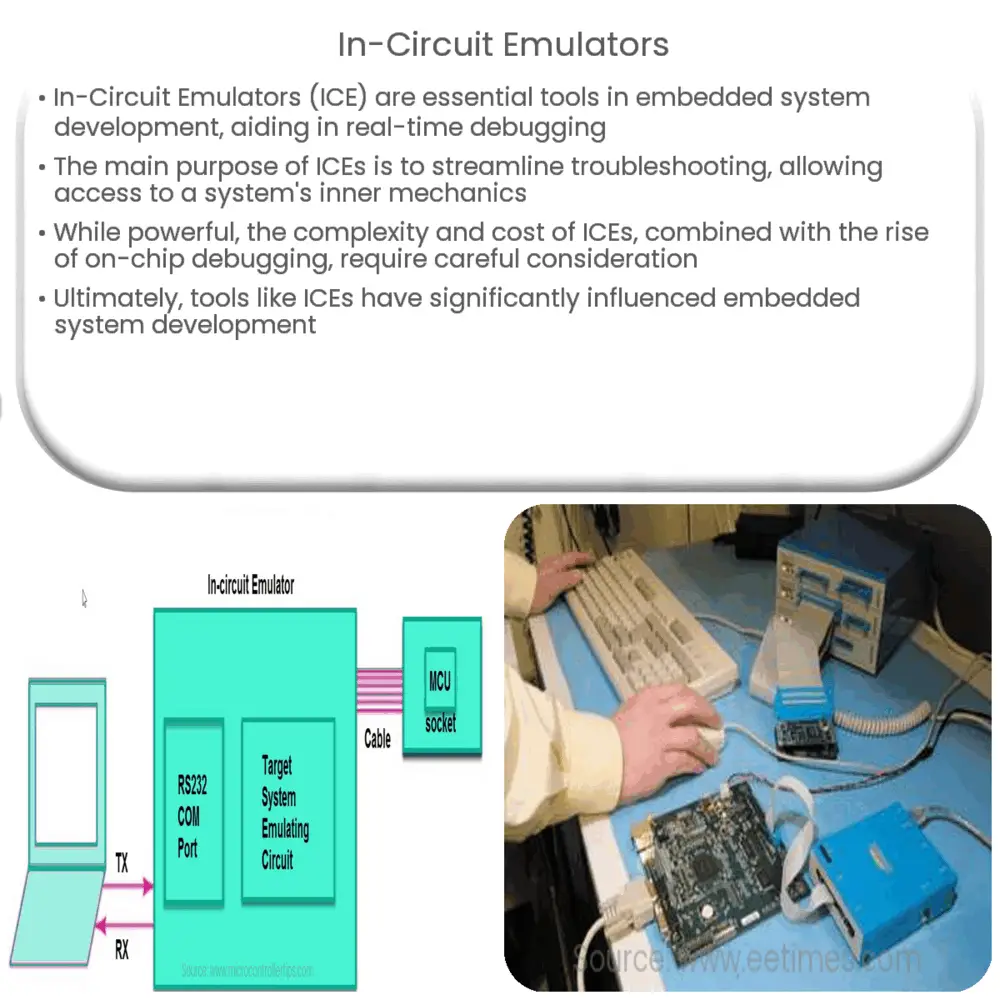Explore the role and significance of In-Circuit Emulators (ICEs) in embedded systems development, their advantages, drawbacks, and alternatives.

Introduction to In-Circuit Emulators
In the vast universe of embedded systems development, one of the essential tools that a developer may need is an In-Circuit Emulator (ICE). An ICE is a powerful tool that facilitates the debugging process, enabling developers to examine and manipulate the inner workings of a program and its interaction with hardware in real-time.
The Purpose of In-Circuit Emulators
The primary purpose of an ICE is to streamline the troubleshooting process in embedded systems development. These emulators can access all the processor’s registers and memory, allowing developers to efficiently track software execution and determine potential issues. Notably, these emulators can perform real-time debugging without altering the system’s timing behavior, a crucial aspect for time-critical applications.
Components of In-Circuit Emulators
Generally, an ICE comprises three significant components. First is the target adapter, which connects the ICE to the target system. Second, there’s the bond-out processor, a customized CPU that allows for direct control over all internal operations. Lastly, we have the emulator base unit, which links the emulator to the host system, often a PC, where developers can monitor and control the emulation process.
Functionality of In-Circuit Emulators
ICEs go beyond the functionality of traditional debuggers by not only allowing developers to set breakpoints and single-step through code, but also offering hardware breakpoint support, real-time trace, and on-the-fly memory and register modification. In essence, ICEs offer a ‘window’ into the system while it is operating, enabling developers to see exactly what is happening inside the hardware and software at any given time.
The Importance of In-Circuit Emulators in Embedded Systems Development
In the realm of embedded systems, where applications are often closely intertwined with hardware, traditional debugging methods might fall short. This is where ICEs prove invaluable, offering deeper insights into system functionality, leading to more efficient code, improved debugging, and overall shorter development times.
In-Circuit Emulators Versus On-Chip Debugging
While ICEs were the gold standard for debugging embedded systems in the past, advances in microcontroller technology have brought about on-chip debugging. This technique employs a debug module built into the microcontroller itself, reducing the need for costly and complex ICEs. However, each approach has its pros and cons, and the choice depends largely on the specific project requirements.
The Pros and Cons of In-Circuit Emulators
There are several advantages and disadvantages associated with the use of ICEs. One of the most significant advantages is the superior level of control and visibility they offer. Developers can watch the execution of a program in real-time, manipulate values in memory, and observe the results immediately. Additionally, ICEs can often provide high-speed emulation and complex break conditions, which can be incredibly beneficial for intricate systems.
However, ICEs are not without their downsides. Their complexity and the extensive hardware manipulation they perform can lead to high costs. Furthermore, the physical connection required between the emulator and the system being tested can introduce issues such as electrical interference, which might affect the system’s behavior. Finally, as technology advances and microprocessors become more integrated and miniaturized, the physical connections necessary for ICEs become more challenging to establish.
Conclusion
In summary, In-Circuit Emulators are powerful tools for embedded system development. They provide unprecedented access to a system’s inner workings, allowing developers to observe and manipulate software execution in real-time. This can drastically improve the debugging process, making it more efficient and leading to higher quality, more reliable systems. However, the emergence of on-chip debugging methods, along with the high cost and complexity of ICEs, has made their use a matter of careful consideration. As with any tool, the choice to use an ICE should depend on the specific requirements and constraints of the project at hand.
Regardless of the chosen method, it’s undeniable that tools like ICEs have shaped the landscape of embedded system development. As technology continues to evolve, it will be fascinating to see how debugging tools and techniques adapt to meet the ever-changing needs of this dynamic field.

